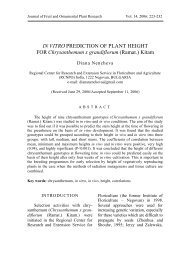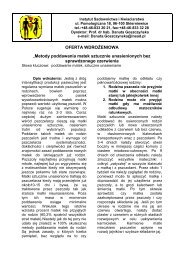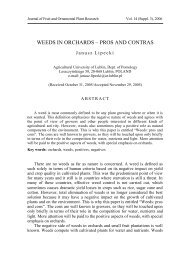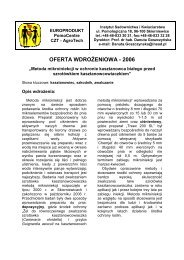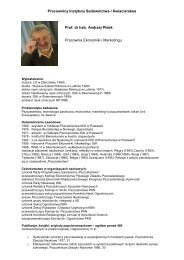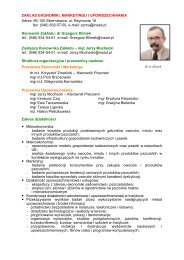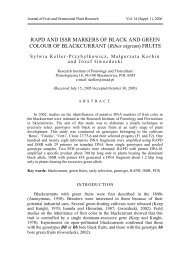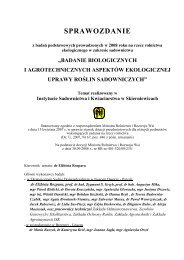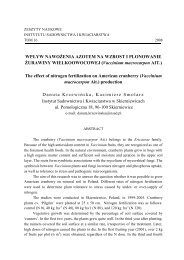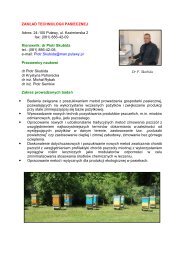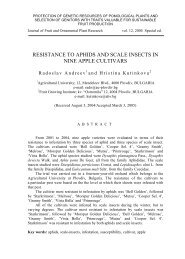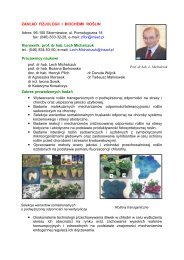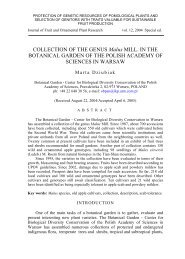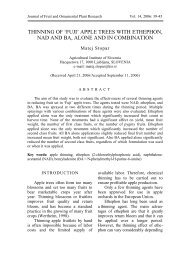and fruitlets' hand thinning of apple trees 'Å¡ampion'
and fruitlets' hand thinning of apple trees 'Å¡ampion'
and fruitlets' hand thinning of apple trees 'Å¡ampion'
Create successful ePaper yourself
Turn your PDF publications into a flip-book with our unique Google optimized e-Paper software.
…fruitlets’ h<strong>and</strong> <strong>thinning</strong> <strong>of</strong> <strong>apple</strong> <strong>trees</strong> ‘Šampion’….<br />
The acidity was measured in the<br />
homo-genate. The solution was<br />
titrated with 0.1 n NaOH to a pH <strong>of</strong><br />
8.1; – this value being accepted as<br />
the neutrality level. The results are<br />
given in percentage values calculated<br />
into malic acid.<br />
A split block design was used,<br />
with three replicates <strong>of</strong> eight <strong>trees</strong><br />
per experimental unit.<br />
The data were statistically collated<br />
using the analysis <strong>of</strong> variance. Tukey’s<br />
multiple range test was used for<br />
means separation at a significance<br />
level <strong>of</strong> 5%.<br />
RESULTS AND DISCUSSION<br />
The quality <strong>of</strong> fruit is expressed<br />
by their size <strong>and</strong> other senoric<br />
attributes such as skin colour, texture,<br />
flovour <strong>and</strong> aroma (Płocharski, 1996).<br />
The degree <strong>of</strong> sweetness <strong>and</strong> tastiness<br />
are affected by the total content <strong>of</strong>,<br />
<strong>and</strong> proportions between, the soluble<br />
solids (especially sugars <strong>and</strong> acids).<br />
One <strong>of</strong> the main aims <strong>of</strong> <strong>thinning</strong> is<br />
to improve the quality <strong>of</strong> fruit, which<br />
greatly depends on crop load. In the<br />
first year <strong>of</strong> this study (1997), the<br />
yield <strong>of</strong> the thinned <strong>trees</strong> did not<br />
differ from that <strong>of</strong> the control ones<br />
(Tab. 2). The <strong>trees</strong> chosen for this<br />
experiment were characterized by the<br />
similarities in their flowering intensity.<br />
The lack <strong>of</strong> differences between<br />
the treatments may be as a result <strong>of</strong><br />
a more intensive natural drop <strong>of</strong><br />
fruitlets from the control <strong>trees</strong>.<br />
Whereas the flowers left after<br />
<strong>thinning</strong> developed into strong fruit,<br />
which in the greater amount remained<br />
up until their harvest. The drop is<br />
always the result <strong>of</strong> strong<br />
competition between fruit (Magein,<br />
1989). Some researchers have stated<br />
that fruit set increased at the higher<br />
source strength, <strong>and</strong> decreased at the<br />
large sink strength (Marcelis <strong>and</strong><br />
Hauvelink, 1999). In 1998, the<br />
subsequent year <strong>of</strong> the study, the<br />
beneficial effects <strong>of</strong> the previous<br />
year's <strong>thinning</strong> on the intensity <strong>of</strong><br />
current year bloom <strong>and</strong> cropping<br />
were observed. The highest yield <strong>of</strong><br />
28.8 kg per tree resulted from the T1<br />
treatment, <strong>and</strong> was significantly<br />
higher than that <strong>of</strong> the control <strong>trees</strong>.<br />
The later terms <strong>of</strong> fruit <strong>thinning</strong> did<br />
not have a significant affect on the<br />
quantity <strong>of</strong> yield, as compared to that<br />
<strong>of</strong> the control <strong>trees</strong>. One <strong>of</strong> the first<br />
who pointed to the possibility <strong>of</strong> tree<br />
yielding regulations by flower<br />
<strong>thinning</strong>, was Crow (1920). He found<br />
that in <strong>apple</strong> <strong>trees</strong> <strong>of</strong> the ‘Wealthy’<br />
<strong>and</strong> ’Duchess <strong>of</strong> Oldenburg’ cultivars,<br />
only <strong>thinning</strong> practices performed<br />
before full bloom promoted fruit<br />
bud initiation. The present explanation<br />
<strong>of</strong> this being that gibberellins,<br />
in the young developing friutlets,<br />
limit the initiation <strong>of</strong> flower buds.<br />
Therefore later in the season, the<br />
gibberellins source decreases <strong>and</strong> has<br />
less influence on the number <strong>of</strong><br />
flower bud sets. In 1999, the last year<br />
<strong>of</strong> the study, each term <strong>of</strong> <strong>thinning</strong><br />
practices produced a significant<br />
decrease in the quantity <strong>of</strong> yield, in<br />
comparison to that <strong>of</strong> the control<br />
<strong>trees</strong>. The smallest yield <strong>of</strong> 20.8 kg<br />
per tree was harvested from <strong>trees</strong><br />
with flowers thinned during the<br />
pink bud stage (T1).<br />
J. Fruit Ornam. Plant Res. vol. 14, 2006: 59-66 61



